Welcome to an in-depth exploration of Thiago Motta’s tactical mastery at Bologna. In this tactical analysis, we unravel the strategic intricacies and footballing philosophy employed by the former midfielder turned manager. Thiago Motta, known for his football intelligence, brings a unique perspective to his coaching role at Bologna, shaping the team’s style and approach.
From formation dynamics to player positioning, we delve into the key elements that define Bologna’s gameplay under Motta’s guidance. Join us on this journey as we dissect the tactical nuances that make Thiago Motta’s Bologna a fascinating team to watch.
Build-up
Low Build-up
In the low build-up, Motta sets his team up in a 4-2-5 formation, with the goalkeeper playing between the center-backs and a box midfield in the middle.
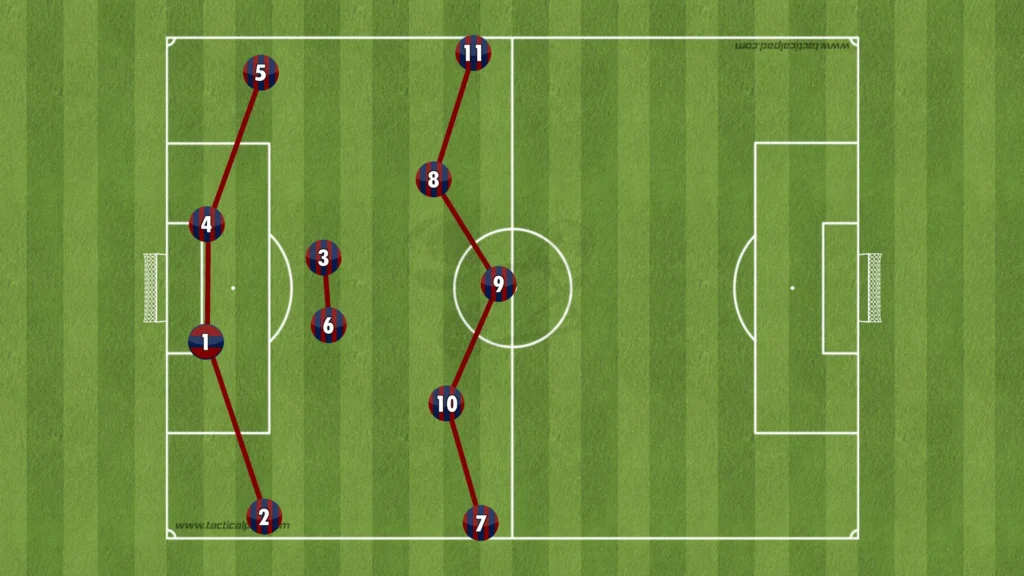
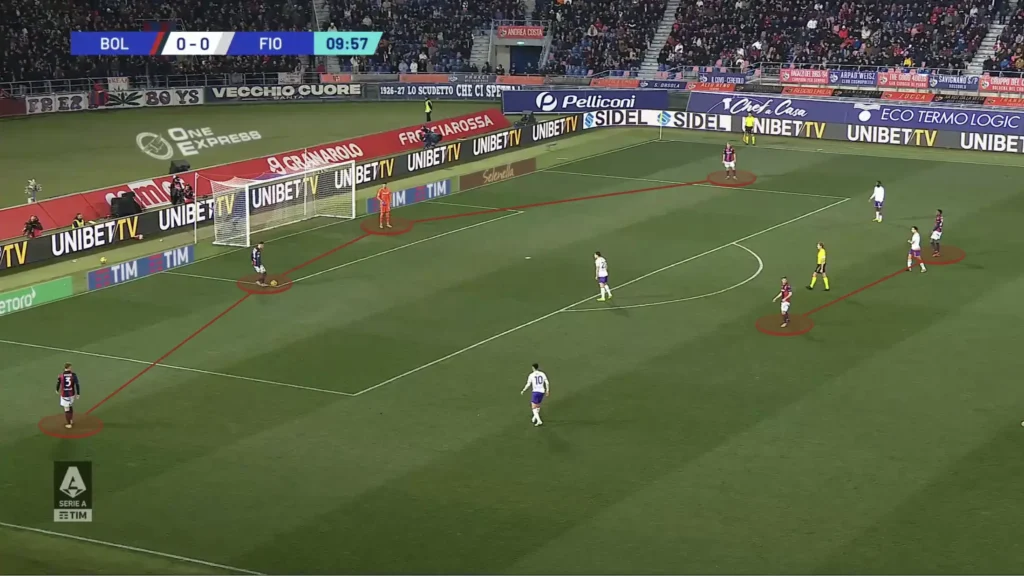
They often drop with the attacking midfielders and like using the goalkeeper, which creates numerical superiorities, allowing them to beat the press.
Thiago Motta’s 2-7-2
Thiago Motta made the headlines a few years ago when he started to talk about his 2-7-2 formation. This confused football fans, who could not understand the practicality of the unconventional formation. Motta later clarified that the numbers do not describe the team’s lines vertically like they usually do. Instead, they represent the team’s lines from Motta’s sideline perspective. He positions two players in the wide areas and seven centrally, which creates a 2-7-2 formation when looked at from the side.
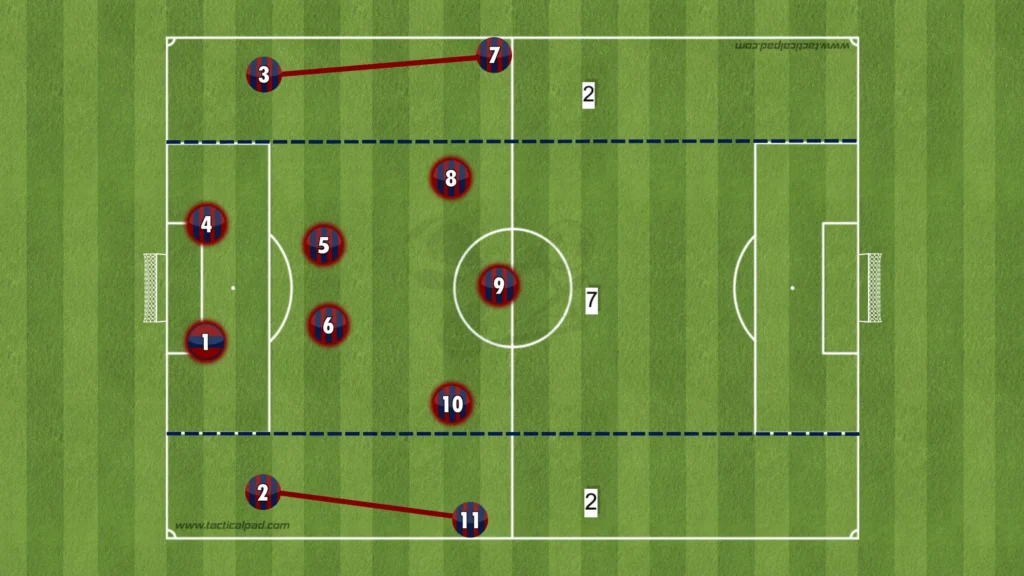
High Build-up
In the high build-up, Motta’s Bologna set up in a 1-3-2-5 formation, the same as in the low build-up without the goalkeeper between the center-backs:
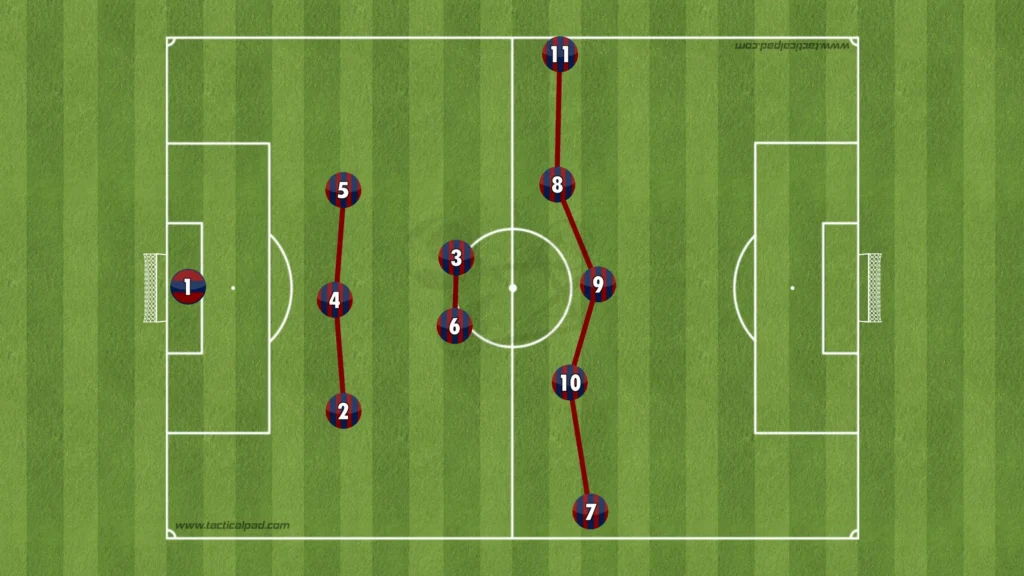

Bologna, however, often rotates in their build-up, creating new formations to confuse opponents. They also adapt to their opponent’s formation to create numerical advantages in different areas, allowing them to beat the defense and score more goals. Their most frequent formation change is to push one of the center-backs into the midfield, creating a 1-2-3-5 formation. Their principles and general guidelines stay the same when they do this.
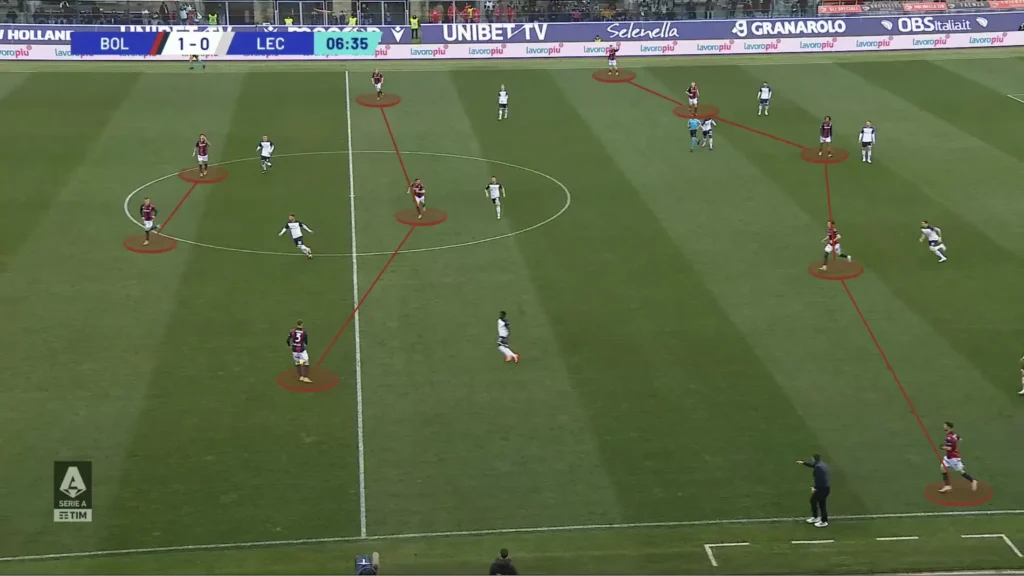
Attacking the Half-Space
Bologna is an excellent team in the final third. They always create chances, mainly by attacking the space between the opposition center-back and fullback. They primarily do this from the wide areas with underlaps from midfielders.
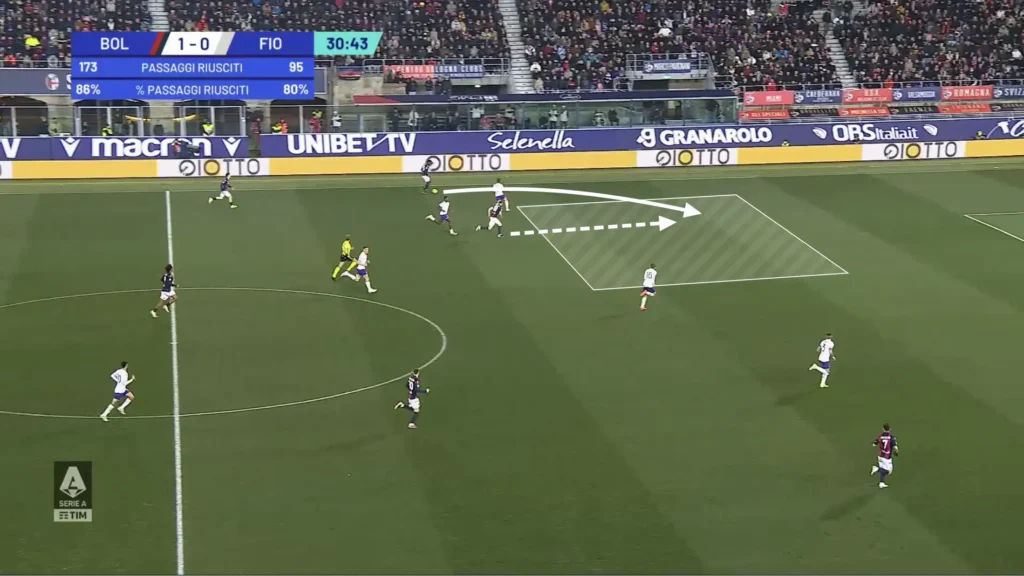
Dropping Striker
Thiago Motta likes to create central overloads when attacking the opposition. Many opponents, therefore, defend with four midfield players to neutralize Bologna’s box midfield. Motta’s answer to this is often to drop with the striker. When the striker drops, they again become numerically superior in the midfield, allowing them to beat the opponent’s defense. If the center-back pushes up on the striker, Bologna will exploit the space in behind.
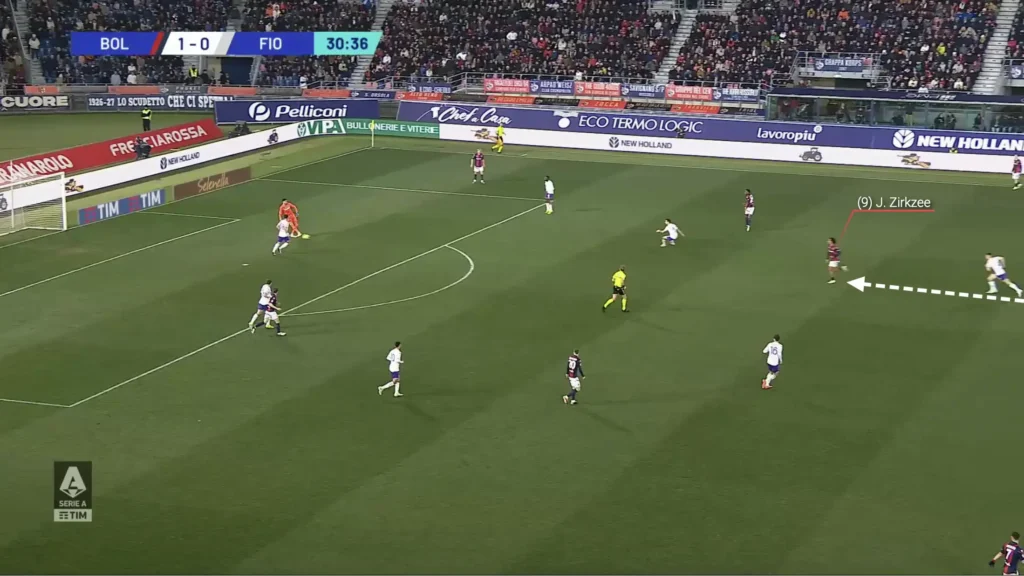
Principles and Tools
Rotations and Interchanges
Thiago Motta has repeatedly shown that he wants his team to play attacking and offensive football, regardless of the opposition. They like keeping possession and are often successful in doing so. One influential principle in doing this is to be fluid within the system and to find different interchanges and rotations. Their most frequent rotation is a counter-movement with a winger and an attacking midfielder. When the fullback gets the ball, the winger runs towards the fullback, dragging the opposition fullback with him. This opens the space behind the fullback, which allows the ball to be played into the open space for a running midfielder.
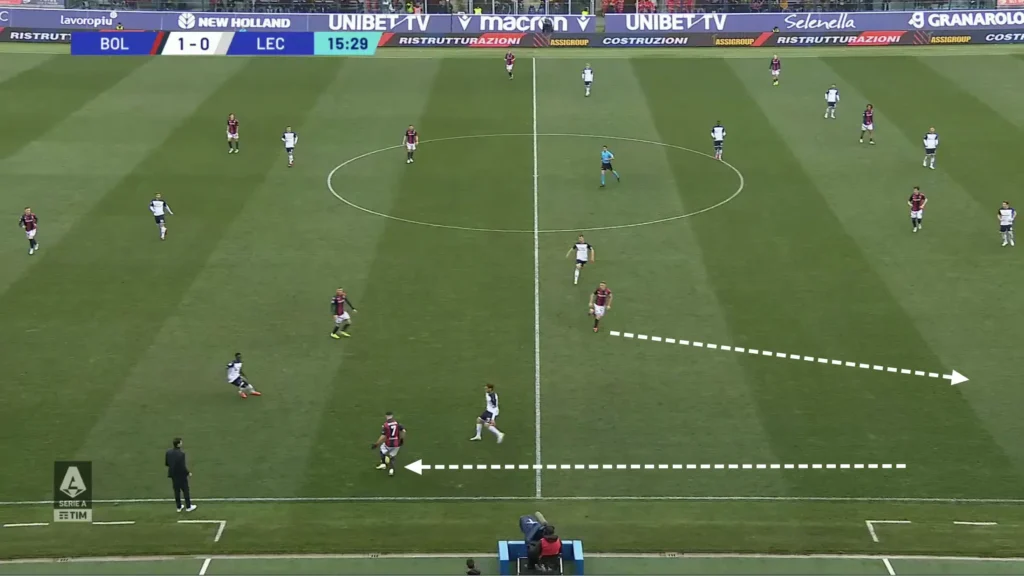
This movement also drags away an opposition midfielder from the center, allowing the striker to drop into the opened space. The fullback will play the ball to the dropping striker, who can turn and attack the defense.
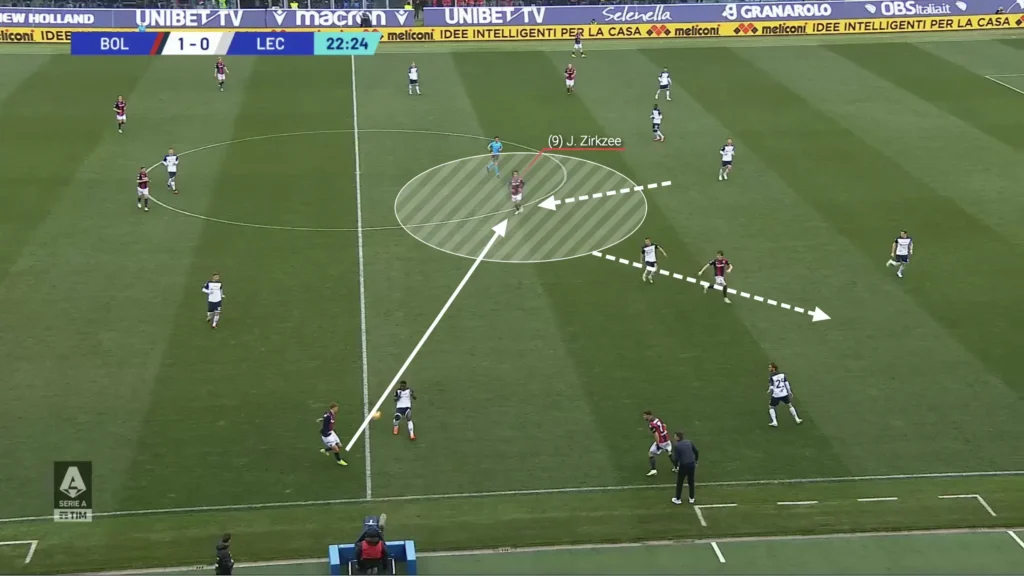
Thiago Motta also wants his center-backs and holding midfielders to rotate and change positions to confuse the opponents. A holding midfielder will often drop, dragging away an opposition midfielder, which opens the space in the middle. A center-back will run into the open space and receive the ball, allowing him to turn and progress the ball up the pitch. While it demands a lot of technical and tactical skills from the players, this fluidity has created new dynamics for Bologna’s attacking style, offering new solutions and ways of beating the opposition’s press.
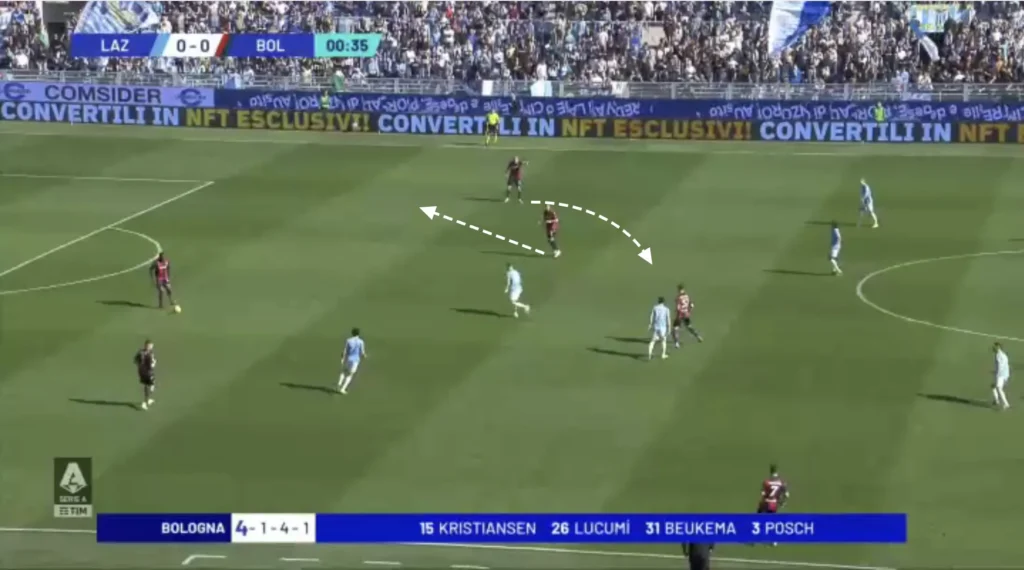
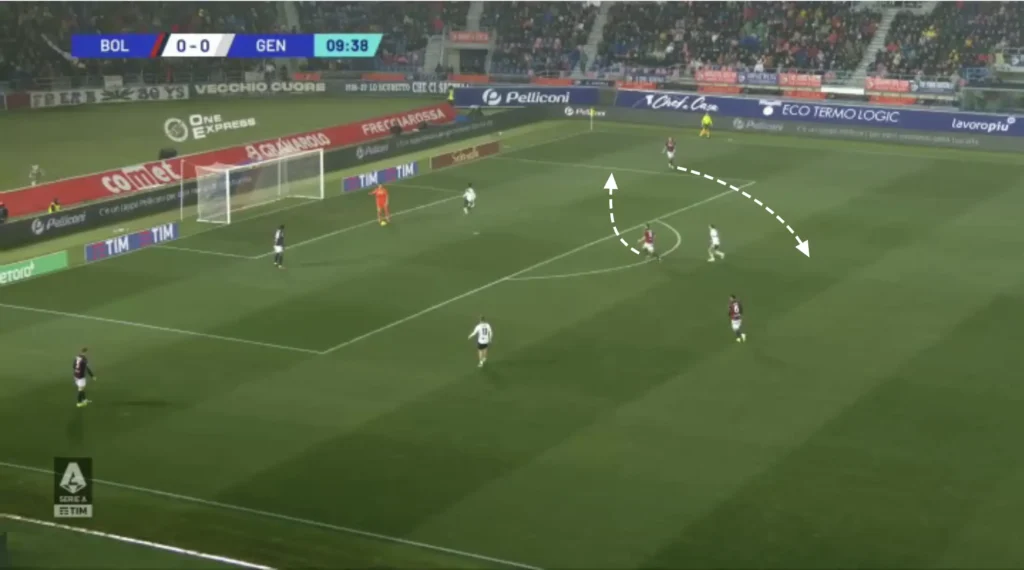
Third-man
Thiago Motta, as established, likes it when his team plays through the opposition when possible. One vital tool that they often use is the third-man principle. This means using a third player to reach a free player whose passing lane is blocked.
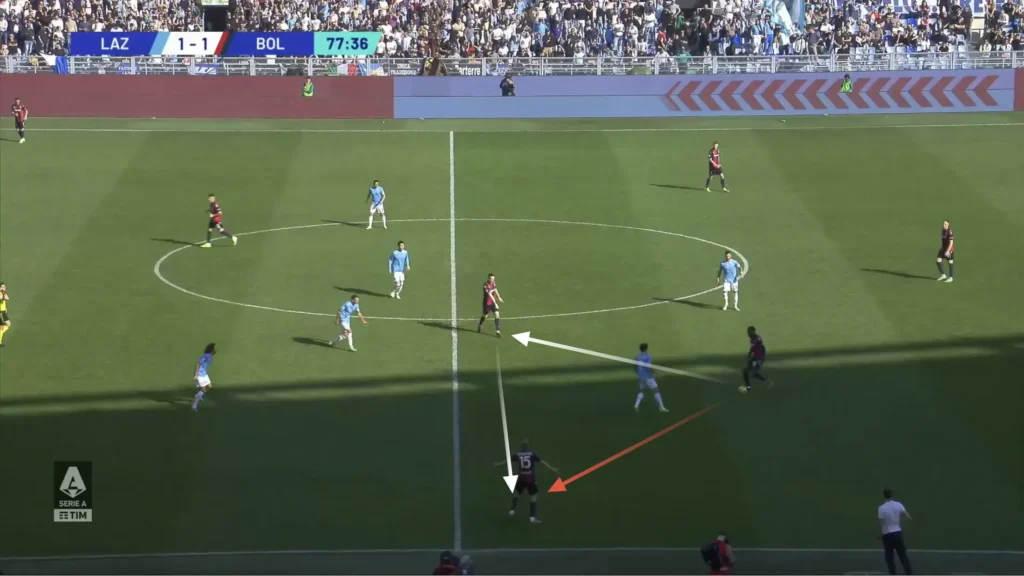
Numerical Advantages
Another massive aspect of Bologna’s high build-up is their ability to create numerical advantages against the opposition’s defensive line. Their front five naturally becomes numerically superior against a back four, which they are great at taking advantage of.
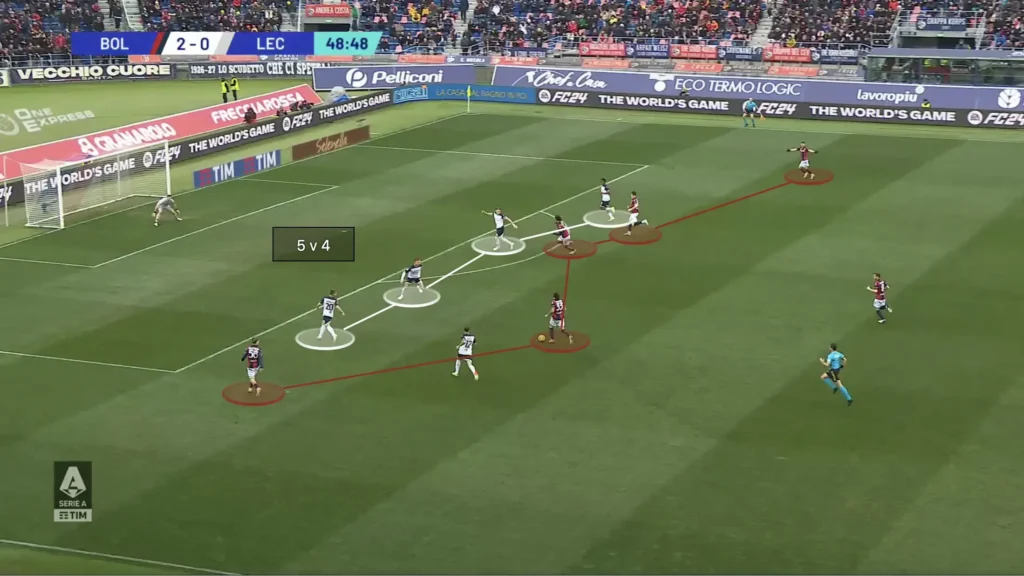
When the defending team is positioned on one side, the weak-side fullback becomes vulnerable to the long switch of play due to the 1v2 against Bologna’s winger and attacking midfielder. Thiago Motta’s team often capitalizes on this by getting the ball to the winger and creating many opportunities from 2v1 situations on the wing and in the half-spaces.
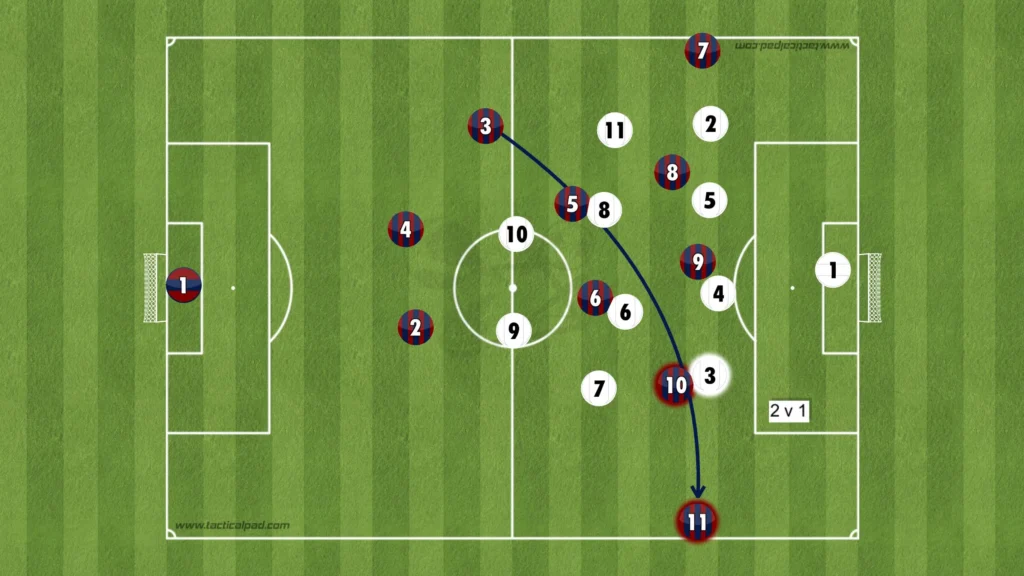
Defending
High Press
Thiago Motta’s team always looks to be aggressive without the ball. This shows in their high pressure. Motta usually wants his team to go man-to-man and intensely press the opposition. Bologna often win the ball high up the pitch and get many goals thanks to their high press.
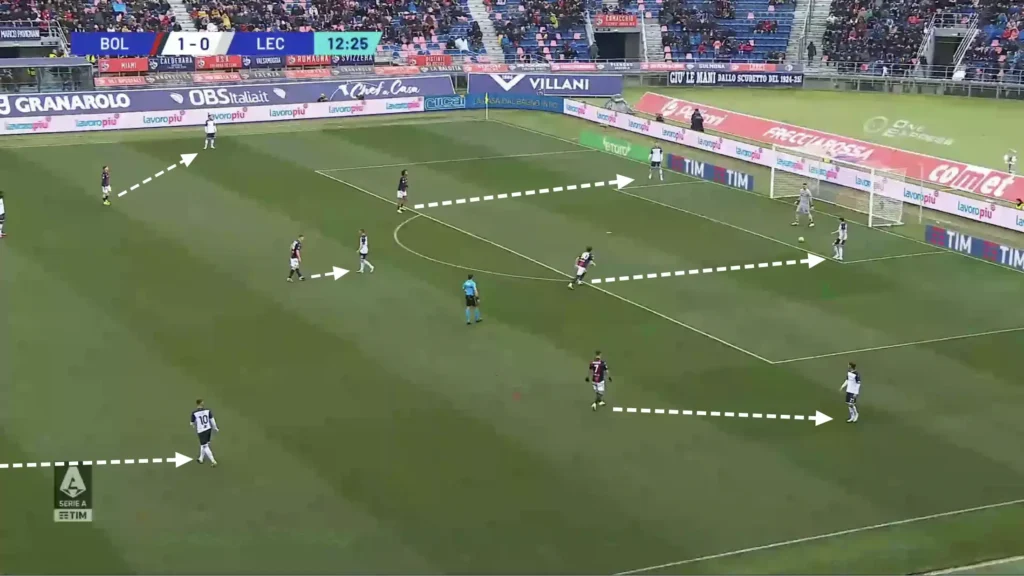
Low Press
In the low press, Motta’s Bologna uses a 1-4-5-1 formation. They look to set up in a mid-block, always trying to close the center, forcing the opposition out wide. Motta wants his team to man-mark the opposition midfielders.
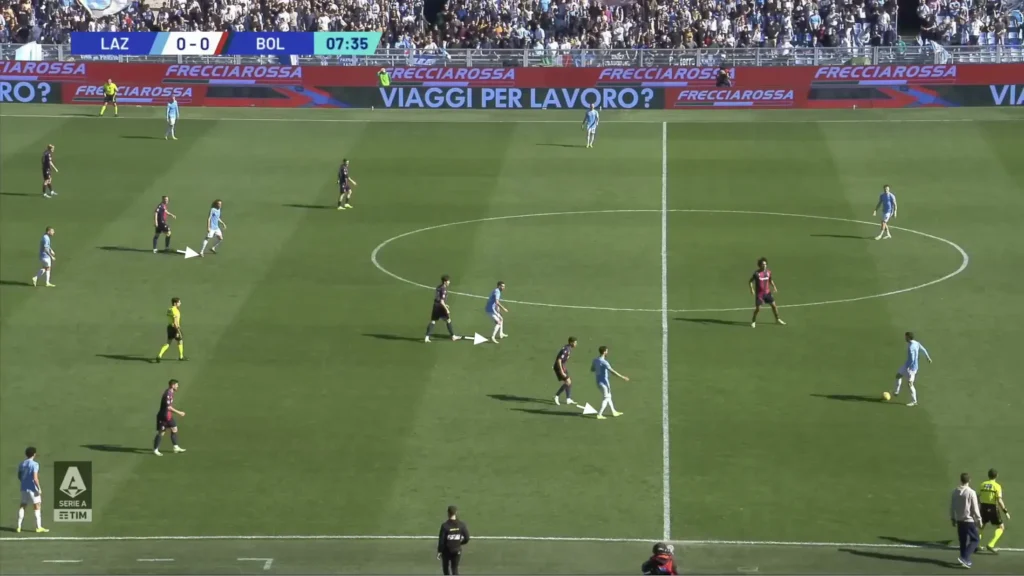
This makes their defensive shape very dynamic because they adapt to their opponents. Here, the opposition forces them to be positioned in a 1-4-1-4-1 formation;
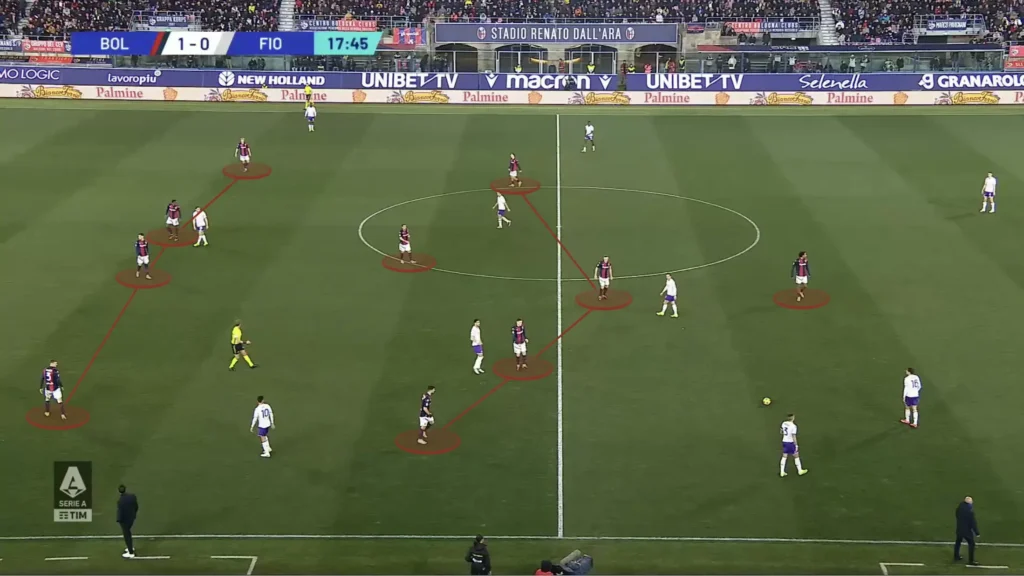
While here, the opponent’s shape forces them to be in a 1-4-2-3-1 formation:
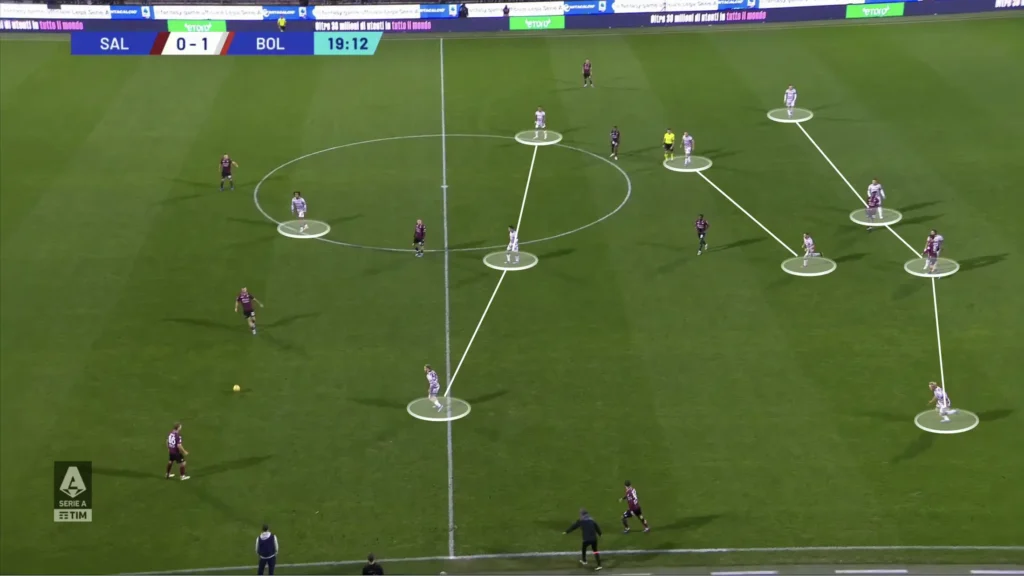
Defensive Transitions
Positioning many players centrally, creating a numerical advantage in the midfield, creates good conditions in defensive transitions. Many players close to the ball after losing possession means that many players can work towards regaining possession. Motta’s team, therefore, often regains possession directly after losing it.
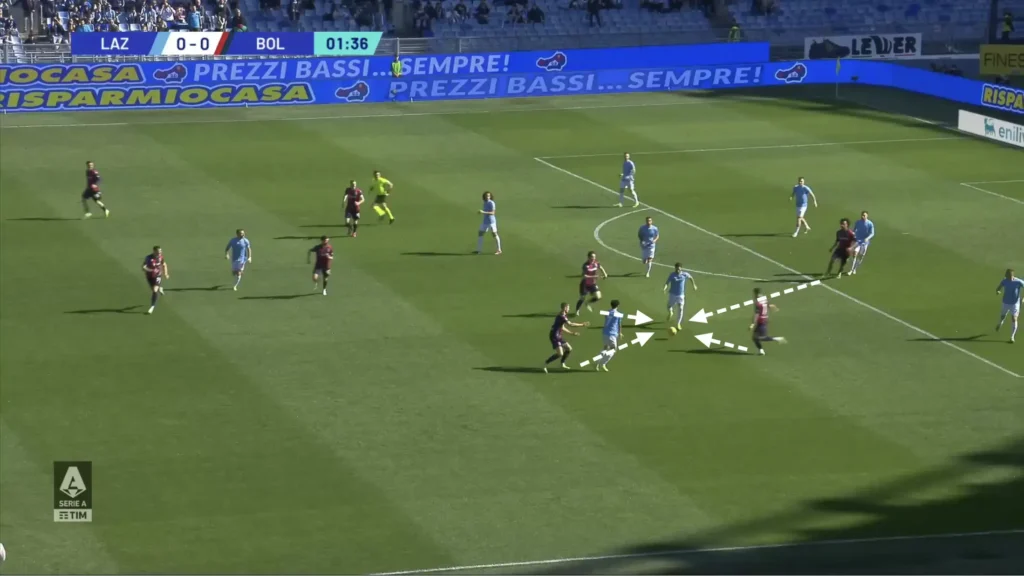
Final Thoughts
In conclusion, this tactical analysis delves into the intricate strategies orchestrated by Thiago Motta during his tenure at Bologna, showcasing the footballing philosophy of the accomplished manager. His build-up intricacies and defensive structures have shown Motta’s influence on the team’s strategic evolution. The fluidity and adaptability demonstrated by Bologna under Motta’s guidance illustrate a commitment to a modern and dynamic style of play.
As Thiago Motta continues to make his mark in the managerial realm, this analysis serves as a snapshot of the tactical nuances employed by the young coach. The emphasis on possession, positional play, and defensive solidity highlights the meticulous approach embedded in Motta’s coaching philosophy. For enthusiasts and football fans, the unfolding tactical narrative at Bologna under Thiago Motta promises an intriguing journey into the strategic dimensions of the beautiful game.
